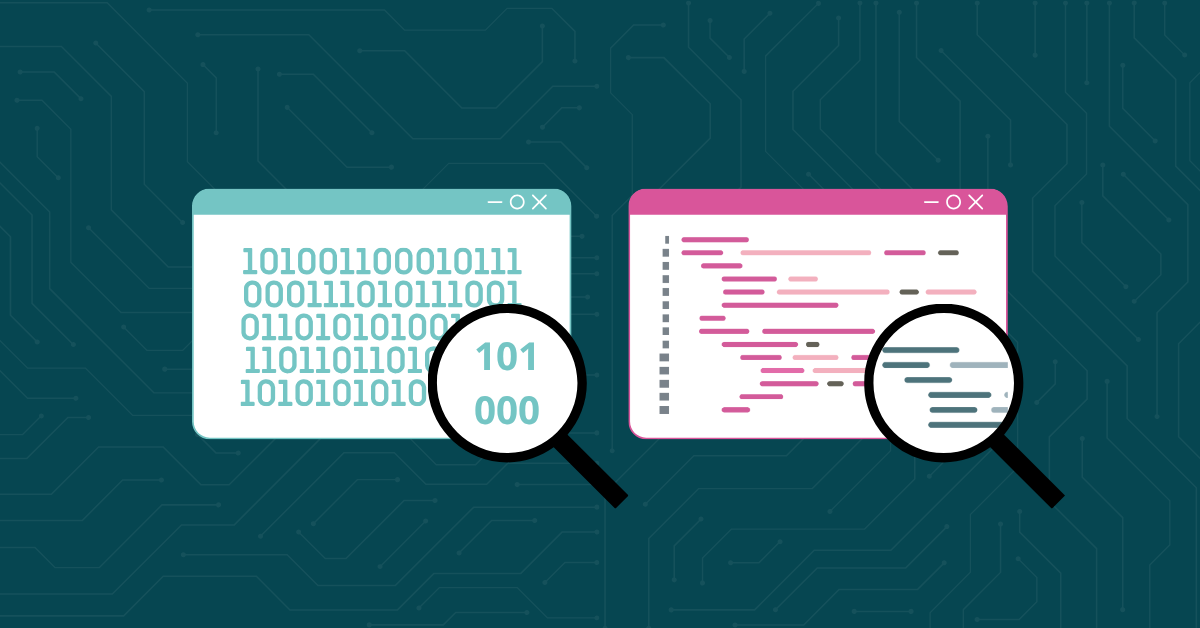

Speeding up releases without sacrificing quality requires a smart testing strategy. Static and dynamic testing, also known as static vs. dynamic code analysis, help developers catch vulnerabilities and defects before they reach production.
This guide explains how static analysis tools and dynamic testing methods work, what types of issues each uncovers, and how to combine both approaches in your software development lifecycle (SDLC) to improve security, reliability, and release speed.
Static testing, also known as static code analysis, examines your code without executing it.
Developers and QA teams use it to review source code and design artifacts for syntax errors, code smells, and potential security vulnerabilities.
Static testing can be performed manually, through code reviews and inspections, or automatically, using tools that scan the code for patterns associated with common errors.
The goal is to improve code quality and security by identifying syntax errors, code standards violations, security vulnerabilities, and other discrepancies before the code is run. By catching errors early, developers can save time and resources that would otherwise be spent on debugging and fixing issues in later stages.
Dynamic testing evaluates how your software behaves during runtime.
Unlike static testing, it executes the application to uncover issues that only appear when the software is running, such as functionality errors, integration bugs, and performance bottlenecks.
Dynamic testing can be applied at various levels, including unit testing, integration testing, system testing, and acceptance testing. Dynamic testing is crucial for assessing the software’s functional and non-functional requirements. It helps ensure the application behaves as expected under different conditions and can handle real-world operations. Techniques such as stress testing, load testing, and dynamic analysis usability testing fall under dynamic testing
While both static and dynamic testing are essential for a comprehensive testing strategy, they differ significantly in their approach and focus. Static testing is proactive, identifying potential issues before the code is executed, whereas dynamic testing is reactive, uncovering bugs that manifest during runtime. Static testing focuses on the code’s structure and syntax, while dynamic testing assesses the software’s operational behavior.
Static testing is often employed in the initial phases of development, even before the code is fully written, to review algorithms, methodologies, and design documents. Dynamic testing is performed after the code has been compiled and is ready for execution, allowing for the assessment of the software’s performance and reliability in a live environment.
Static testing focuses on analyzing code for adherence to coding standards, readability, and maintainability, making it ideal for identifying potential security vulnerabilities within the code or design.
It also ensures that documentation accurately describes the software’s functionality and design, facilitating easier maintenance and compliance. Static testing also reviews the software design with an eye for architectural standards and best practices.
Dynamic testing checks if the software performs as expected under various conditions. It also assesses the software’s responsiveness, speed, scalability, and stability under specific workloads. Plus, dynamic testing can help ensure the user interface is intuitive and user-friendly.
Static testing identifies syntax errors, dead code, memory leaks, and security vulnerabilities. Dynamic testing, meanwhile, excels at finding runtime errors, integration issues, and performance problems.
Both methods are essential for a complete testing strategy, but they target different issues:
| Static testing (Static code analysis) | Dynamic testing (Runtime analysis) |
| Proactive: catches issues before execution | Reactive: finds bugs during runtime |
| Focuses on code structure, syntax, and logic | Focuses on software behavior and interactions |
| Identifies syntax errors, security flaws, and code smells | Identifies runtime errors, integration issues, and performance problems |
| Performed with SAST tools or manual code review | Performed with DAST tools and runtime testing |
Takeaway: Combining static and dynamic code analysis provides development teams with the best opportunity to identify issues early, prevent production defects, and enhance overall software security.
An effective testing strategy depends not only on the type of testing performed but also on the tools and metrics used to measure its effectiveness. Static analysis tools and dynamic application security testing (DAST) tools are two essential components in a developer’s toolkit, each offering different insights at different stages throughout the software development lifecycle.
Static analysis tools scan source code during compile time, without executing the program. These tools identify structural flaws, enforce best practices, and highlight known vulnerabilities before they escalate into production issues. They also help ensure regulatory compliance by flagging code that deviates from industry standards and secure coding guidelines.
DAST tools operate by testing a running application, providing dynamic feedback about vulnerabilities like runtime vulnerabilities, authentication bypasses, or improper input validation—many of which only appear under live conditions.
Teams often use metrics such as code coverage and defect density to evaluate the effectiveness of both static and dynamic testing methods. High code coverage indicates that a large portion of the application has been exercised by tests, increasing confidence in the software’s resilience. However, code coverage alone isn’t enough. It must be combined with strong testing methods to catch security issues and logic flaws. It must be coupled with thoughtful testing methods that target both surface-level syntax and deep behavioral logic.
By combining static and dynamic testing approaches, development teams gain a holistic view of both potential and active flaws. This hybrid approach empowers teams to identify issues early, refine software architecture, and ensure better alignment with performance, security, and compliance goals.
Even the most rigorous testing plans can leave blind spots if they lean too heavily on either static or dynamic testing alone. Different testing strategies uncover different types of issues, and failing to recognize this distinction can result in unresolved defects being introduced into production.
Logical errors often follow valid syntax but produce incorrect results—something that static testing alone might not flag. These errors may only manifest during code execution, when user input, system state, or external data provoke unintended outcomes.
Dynamic testing is better suited to identifying runtime vulnerabilities, which occur as the software interacts with real-world resources. These issues include memory mismanagement, excessive memory usage, and performance bottlenecks. Improper memory handling can cause buffer overflows—high-risk vulnerabilities that static analysis tools often catch during the development phase.
Static analysis can catch faulty code patterns and flag them before they contribute to larger application issues down the road. Additionally, it helps validate how well code adheres to architectural principles, which becomes especially important in large systems where system interactions are complex and interdependent.
The takeaway? Static testing tells you what the code could do wrong, while dynamic testing shows you what the code does wrong. Together, they create a feedback loop that reduces risks and builds confidence in your final product.
Kiuwan offers a comprehensive suite of software tools designed to streamline and enhance your static and dynamic testing efforts. Our software integrates seamlessly into your development pipeline, offering real-time insights and actionable feedback to enhance your software quality and security posture.
Kiuwan’s static application security testing (SAST) is a powerful solution for conducting a thorough static analysis of your codebase. It scans your source code, identifying runtime errors, vulnerabilities, and compliance issues against industry standards and security best practices. With Kiuwan SAST, you can identify and resolve security flaws early in the development process, significantly reducing the risk of security breaches and data leaks.
Our code quality and governance tool extends beyond security to encompass overall code quality and architectural integrity. Its dynamic analysis examines your code against a comprehensive set of quality metrics to identify areas for improvement and ensure adherence to coding standards. This software empowers teams to maintain a high standard of code quality, fostering better maintainability, reliability, and scalability of software projects.
Detect code issues early and reduce risk with Kiuwan’s static and dynamic testing tools.
Start your free trial of Kiuwan’s static and dynamic testing tools to boost security, speed up delivery, and stay audit-ready from the first commit.
No. While static analysis tools are excellent at identifying structural flaws, code patterns, and known vulnerabilities during compile time, they can’t detect runtime vulnerabilities that emerge during code execution. For full security coverage, combine them with DAST tools.
Code coverage measures how much of your application’s logic has been tested. It helps ensure that critical paths and edge cases are evaluated for runtime issues, but keep in mind that high coverage doesn’t guarantee bug-free code. The quality of testing methods matters just as much.
Dynamic testing is essential for finding buffer overflows, application issues, and system interactions that lead to crashes, slowdowns, or security breaches. These problems typically don’t show up until the software is running in a real-world environment.
Static code analysis tools help developers catch potential vulnerabilities, security issues, and code smells during the early stages of development, before the application is even executed. This approach, often part of white box testing, improves code quality by enforcing best practices and reducing the risk of production incidents down the line. By identifying vulnerabilities early, teams save time, reduce rework, and ship more secure software faster.
Static testing finds configuration issues in code, scripts, or environment files by analyzing their structure and logic without running the application. Dynamic testing, meanwhile, identifies runtime misconfigurations and production-level defects, such as missing environment variables or incorrect API endpoints, by executing the application in a test environment. Together, these methods reduce the likelihood of production incidents caused by untested or improperly configured settings.


